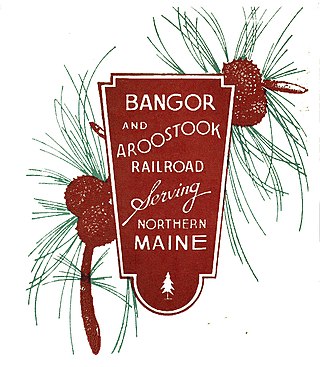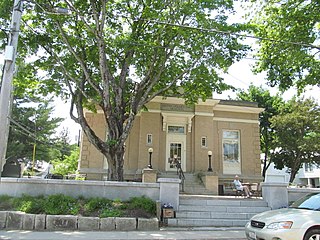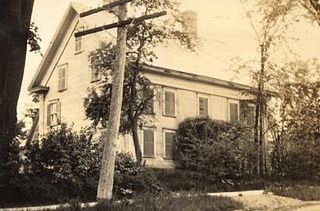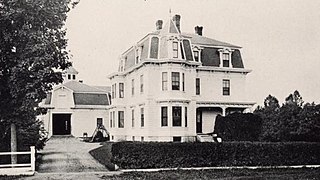
The Bangor and Aroostook Railroad was a United States railroad company that brought rail service to Aroostook County in northern Maine. Brightly-painted BAR boxcars attracted national attention in the 1950s. First-generation diesel locomotives operated on BAR until they were museum pieces. The economic downturn of the 1980s, coupled with the departure of heavy industry from northern Maine, forced the railroad to seek a buyer and end operations in 2003. It was succeeded by the Montreal, Maine and Atlantic Railway.

The Bridgton Public Library, formerly the Dalton Holmes Davis Memorial Library, is the public library of Bridgton, Maine. It is located at 1 Church Street, in an architecturally distinguished Classical Revival building designed by Harry S. Coombs and built in 1913. The building is listed on the National Register of Historic Places.
Market Square Historic District may refer to:

The Bangor Fire Engine House No. 6 is a historic former fire station at 284 Center Street in Bangor, Maine. Built in 1902, it is a high quality local example of Beaux Arts architecture, and is one of a series of important public commissions by local architect Wilfred E. Mansur. The building was listed on the National Register of Historic Places on April 7, 1988.

Oakfield Station is a historic former passenger rail station on Station Street in Oakfield, Maine. The station was built in 1911 by the Bangor and Aroostook Railroad, and is a major reminder of Oakfield's onetime importance as a railroad center. The station is home to the Oakfield Railroad Museum which is operated by the Oakfield Historical Society. It was listed on the National Register of Historic Places on June 25, 1987.

The Clinton Downtown Historic District is a historic district located in the village of Clinton in Clinton Township in the northernmost portion of Lenawee County, Michigan. It consists of most of the 100 block of U.S. Route 12, known locally as West Michigan Avenue, plus Memorial Park at 200 West Michigan. The district was added to the National Register of Historic Places on April 27, 2010.

The Aroostook County Courthouse and Jail is located on Court Street in the center of Houlton, Maine. The building was built in 1859 and was added to the National Register of Historic Places on January 26, 1990. Its oldest portion dates to 1859, built to a design by Gridley J. F. Bryant, and was the county's first purpose-built court facility. Later additions in 1895 and 1928 added wings that give the building its present shape. It was listed on the National Register of Historic Places in 1990.

The Blackhawk Putnam Tavern is an historic house at 22 North Street in Houlton, Maine, United States. Built in 1813, it is the oldest standing building Aroostook County. In the mid-19th century it served as a tavern on the military road, and one of its owners was Blackhawk Putnam, a veteran of the American Civil War. It was listed on the National Register of Historic Places on January 30, 1976.

The Great Fire of 1911 Historic District is located in downtown Bangor, Maine, and has been listed on the National Register of Historic Places since 1984. It preserves Maine's most significant collection of early 20th century public and commercial buildings, and commemorates an urban re-building campaign matched only by Portland's following its own destruction by fire in 1866. The Great Fire of 1911 was Maine's last large-scale urban conflagrations, but resulted in the creation of an early 20th-century urban space relatively unique in Maine or northern New England.
Wilfred E. Mansur (1855–1921) was the most prominent architect in late 19th and early 20th century Bangor, Maine.
The Amazeen House is an historic house at 15 Weeks Street in Houlton, Maine, United States. This imposing 2+1⁄2-story Italianate house was built c. 1882 as a speculative venture, probably intended for use as a hotel, based on the projected route of the New Brunswick Railway. It is one of Houlton's most impressive 19th-century houses, and was listed on the National Register of Historic Places in September 1986.
The Edward L. Cleveland House is an historic house at 87 Court Street in Houlton, Maine. A distinctive local example of Queen Anne and Colonial Revival architecture, it was built in 1902 by Edward L. Cleveland, one of Aroostook County's largest dealers in potatoes, and was listed on the National Register of Historic Places in June 1987.

Walter P. Mansur House is an historic house at 10 Water Street in Houlton, Maine. Built in 1880, it is the most architecturally sophisticated Second Empire building in northern Maine. It was built for Walter P. Mansur, a prominent local businessman and banker. The house was listed on the National Register of Historic Places in February 1990.

The Philo Reed House is an historic house at 38 Main Street in Fort Fairfield, Maine. Built in 1907 to a design by Coombs and Gibbs, it is one of the town's grandest houses, a transitional combination of Queen Anne and Colonial Revival styling. It was built for Philo Reed founder of one of the nation's largest seed potato companies of the time. It was listed on the National Register of Historic Places in April 1986.

The Graham Building is a yellow-brick Romanesque Revival style commercial building in downtown Bangor, Maine, at the corner of Harlow and Central Streets. It is one of the most prominent buildings in the Great Fire of 1911 Historic District, which is listed on the National Register of Historic Places.

The Rumford Municipal Building is located on Congress Street in the central business district of Rumford, Maine. Built in 1915 to a design by Lewiston architect Harry S. Coombs, it continues to house the town's municipal offices today. It is a fine example of Colonial Revival architecture, representing the town's growth in the early decades of the 20th century, and was listed on the National Register of Historic Places in 1980.

The First National Bank of Houlton is an historic bank building on Market Square in the center of Houlton, Maine. Built in 1907, it is an excellent local example of neo-Greek Revival architecture. One of the last commissions completed by Lewiston architect George M. Coombs, it was listed on the National Register of Historic Places in 1973. In 2020, the building's occupant bank changed its location after 113 years.

The West Market Square Historic District encompasses one of Bangor, Maine's central urban business districts. Located at the junction of Main and Broad Streets, it has been a focal point of Bangor's economy and business since the city's incorporation in 1834. The district includes seven buildings reflective of its appearance in the late 19th and early 20th centuries; it was listed on the National Register of Historic Places in 1979.

The Aroostook County Historical and Art Museum is located at 109 Main Street, in the White Memorial Building, in Houlton, Maine. The museum was founded in 1937, after the building, a handsome 1903 Colonial Revival house, was donated to the town by the White family. The building was listed on the National Register of Historic Places in 1980. The Houlton Museum's collections include artefacts and documents from Ricker Classical Institute and Ricker College; the photography collection of E. B. White; militaria and domestic objects; and art from the Houlton POW camp from WWII.

The South Royalton Historic District encompasses the central portion of the village of South Royalton, Vermont. Now the town of Royalton's principal commercial center, it developed in the second half of the 19th century around the depot of the Vermont Central Railroad. The district includes fine examples of Greek Revival and Victorian architecture, and is home to the Vermont Law School. It was listed on the National Register of Historic Places in 1976.



















